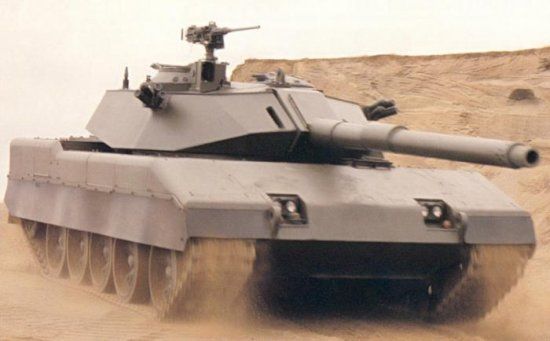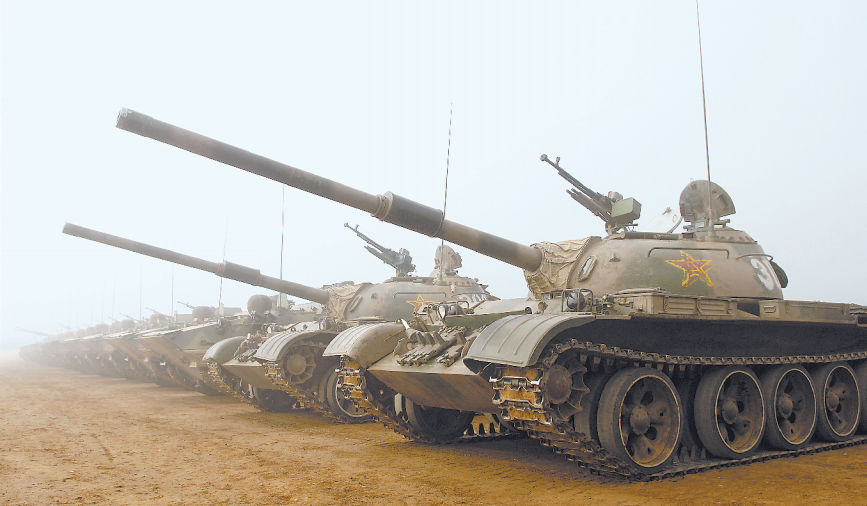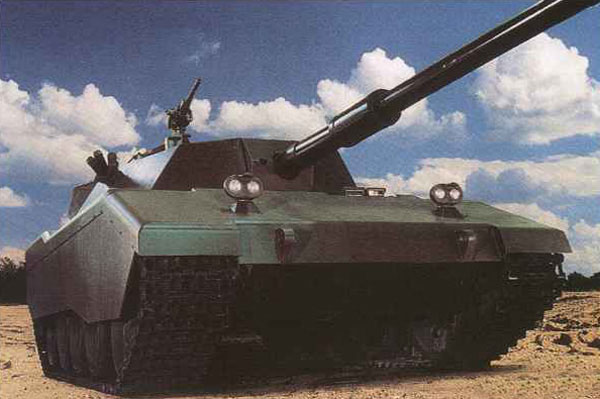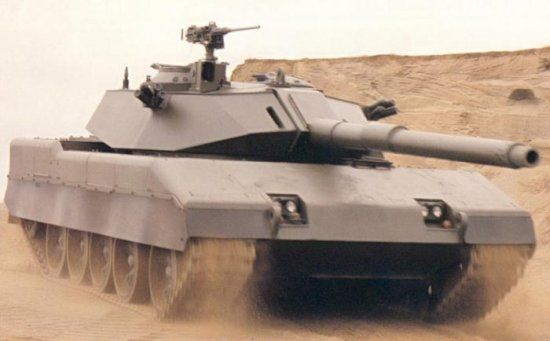
The Jaguar Main Battle Tank was a joint Chinese-American project undertaken in the late 1980’s for a main battle tank design based on the Chinese Type 59 (WZ120). The 1970’s saw prosperous and progressive changes in the relationship between the United States of America and the People’s Republic of China. Since the establishment of the People’s Republic of China’s in 1949, the two countries had adopted a confrontational and hostile attitude towards each other. Tensions had only increased since the Korean War, when the two sides met each other face-to-face in the battlefield. However, the deterioration of relations between the Soviet Union and China in the 1960’s had allowed the United States to potentially gain a new ally against the Soviets. United States President Richard Nixon’s 1972 visit in Beijing affirmed the ties between the two countries, and formal relations were established. This détente of Sino-American relations marked the start of a new age of diplomacy. Following Mao Zedong’s death in 1976, China had begun to move towards a more progressive economy to undo the damage caused by the Cultural Revolution to China’s already struggling economy. China’s paramount leader Deng Xiaoping initiated the Chinese economic reform in late 1978, opened the country up to foreign investors, and allowed private businesses to thrive. As a result of this, numerous American companies partnered up with Chinese companies in the 1980s to initiate private projects of military nature. One of such projects was the “Jaguar” main battle tank developed by Cadillac Gage Textron and the China National Machinery & Equipment Import and Export Corporation.
Development History
In 1984, the Cadillac Gage Textron and the China National Machinery & Equipment Import and Export Corporation (CMEC) had envisioned the development for a low-cost “3rd World Main Battle Tank” (MBT) based on the aging Chinese Type 59 (WZ120) medium tank design, and using Western technology. The project was given the name of the “Jaguar”, or “美洲虎”(měizhōu hǔ) in Chinese. The Jaguar would be readily available on the overseas arms market for any country operating the T-54, T-55, or Type 59 designs and looking for an affordable upgrade to their tank arsenal. In addition to the overseas arms market, the Jaguar design team also had intentions to enter the Chinese market itself and replace (or upgrade) the People’s Liberation Army’s Type 59 tanks. It was agreed upon by the two firms that each side would provide 40% of the components while the remaining 20% would be outsourced from other foreign contractors. It is also interesting to note that the reason Cadillac Gage chose to partner with CMEC, as suggested by Military Technology (MILTEC) magazine, was because CMEC had no prior involvement in defensive military technology or marketing military technology overseas, and had more political power than Norinco. This would have benefited the Americans, as the Jaguar design would possibly gain more favor with the Chinese government, and it would have made CMEC reliant on Cadillac for arms production or marketing guidance. The responsibility of marketing and advertising the Jaguar would solely fall onto Cadillac Gage.

It was estimated by the designers that a modern upgrade for the T-55 and its variants to Western standards would cost approximately $880,000 to $1,000,000 USD, so it would be necessary to keep the price of the Jaguar to no more than a million dollars for economic feasibility. The profits of each Jaguar unit sold would be split equally between Cadillac Gage and CMEC. Furthermore, it would appear that the Jaguar program’s pricing decision was also determined based upon the design team’s decision to compete with the Type 59 and Type 69 (WZ121) tanks being offered on the arms market by China’s other military technology conglomerate Norinco for approximately $650,000 USD. Though more expensive, the Jaguar was considerably superior in terms of firepower, protection, and technology. The Jaguar tank and the collaboration between Cadillac Gage Textron and CMEC was announced publicly in October of 1988 at the Defendory arms exhibition fair hosted in Athens, Greece. The intended market targeted by the designers was stated to be Africa and the Far East (some sources specified Southeast Asia) where the T-54, T-55, and Type 59 are especially common. The Jaguar’s capabilities were advertised by Cadillac Gage as being on-par with the American M60A1 tank, and it was well received by many observers. It was also maintained by the design team that the Jaguar’s modern design could very well last into the 21st century.
The design team’s intentions to enter the Chinese market and win a contract with the People’s Liberation Army to replace or otherwise upgrade their Type 59 tanks was quite ambitious. Were it to reach that stage, it would indubitably enter competition with China’s indigenously developed Type 80 / Type 88 (ZTZ80 / ZTZ88) tanks. The design team had also stated their intentions to replace or upgrade all of the T-54, T-55, and Type 59 tanks in the Far East to that of the Jaguar. However, such an undertaking was overambitious and would have taken an unimaginable amount of time to fulfill. As one Chinese magazine stated, “this piece of the market is like a large cake, large to the point that not even the two Chinese and American companies could consume it, even in ten or so odd years.”
First Prototype Production

The next step for the Jaguar program was to produce prototypes for field and firing trials in order to gauge out the validity of the design. CMEC was able to provide Cadillac Gage with two Type 59 tanks, which were shipped to the United States and converted to the Jaguar design. Work had begun on the prototype conversion by late 1988, and had been completed by the end of that year. Once the pilot model was completed, the Jaguar began mobility trials in Nevada in December, followed by firing trials in January. After testing in the United States, the Jaguar prototype was shipped to China for further testing, and returned to the United States following these Chinese trials. Few details are known regarding the results of the testing by both Cadillac Gage and CMEC. All issues of the Jaguar tank revealed through testing were noted and planned to be corrected in the second prototype, which was planned to be produced in China by CMEC with support by Cadillac Gage. It was envisioned by the design team that production of the Jaguar would be undertaken in China, citing cheaper production costs as the main reason. All newer components (ie. transmissions, engines, etc) would be produced in the United States or purchased from foreign contractors and delivered to China in order to facilitate production. The Jaguar was expected to have entered production in 1990 or 1991, assuming the tank had successfully passed trials and received orders from foreign customers. Once the design team received an order from a client, it was estimated that it would take up to eighteen months for serial production to start.
Design
Being a relatively modern design intended for the competitive international arms market even now, much of the Jaguar’s specific technical details have yet to be released. However, a decent amount of information was divulged to the public by the design team for the purpose of marketing and advertising. The tank would have been crewed by a team of four, consisting of a driver, gunner, loader, and commander. The first Jaguar prototype was heavily based upon the chassis of the Type 59 tank, provided by CMEC as part of the development agreement. Nearly all of the Type 59’s components were replaced.
The interior of the Jaguar prototype appears to have maintained the layout of the Type 59 tank. The driver was located in the frontal left part of the vehicle, while 105 mm (4.13 in) ammunition was stored to his right. The driver was provided with a single-piece hatch door to enter and exit from, with optics for day driving. If requested by a client, one of the optics can be replaced by a passive night periscope. The gunner and commander were located on the right side of the turret, while the loader was on the left, which is the opposite of the original Type 59’s layout. The loader and commander were both provided a single-piece hatch which opened rearwards for them to enter and exit from.
The Type 59’s original 520 hp (390 kW) Norinco Type 1215L V-12 liquid-cooled diesel engine was swapped out for an American-made 8V-92TA liquid-cooled diesel two-cycle supercharged V-8 engine developed by the Detroit Diesel Corporation, which was capable of producing 750 hp (559.5 kW). The upgraded powerplant gave the tank a power-to-weight ratio of 16.19 hp per ton (13.32 kW per tonne) which allowed the prototype to reach a top speed of 55 km/h (34.16 mph). A 24-volt electrical system was also fitted to the tank, presumably to power the tank’s electronic devices. Though not certain, it is speculated by some sources that any production Jaguar tanks would have received an even more powerful engine, as the performance of the initial prototype was rather subpar to other Western designs. The Type 59’s transmission was replaced by an American-made XTG-411 produced by the Allison Transmission Division of General Motors Corporation, with four forward gears and two reverse gears. In terms of suspension, the prototype Jaguar maintained the Type 59’s torsion bar suspension with five rubber road wheels on either side. The idler was placed in the front of the tank while the drive sprocket was placed in the rear with two track-return rollers. Modifications were made to strengthen the torsion bar suspension system, which ensured better vertical wheel traverse. The running gear of the Jaguar was protected with a rubber skirt. In terms of tracks, the Jaguar prototype maintained the original Chinese steel tracks, despite it having an inferior service life to Western tracks. It is unknown whether or not these would be replaced in production models. Production Jaguar tanks would have the option to mount a hydropneumatic suspension system developed by Cadillac Gage, allowing the Jaguar to adjust its height in accordance to the terrain, and to increase and decrease gun elevation angles.
The converted Type 59’s original rifled 100 mm (3.39 in) Type 59 tank cannon, based on the World War II-era Soviet D-10T design, was replaced by an American 105 mm (4.13 in) M68 tank gun, which itself was a copy of the British Royal Ordnance L7 cannon. The Jaguar’s armament could fire all compatible NATO rounds, including Armor Piercing Fin-Stabilized Discarding Sabot (APFSDS) rounds, and High Explosive Anti Tank Fin-Stabilized (HEAT-FS) shells. A total of 34 rounds would be stored for the main cannon. Production Jaguar variants would have had three different tank guns to choose from, a Chinese version of the British L7 (which was alleged to have been developed from Israeli technology), a standard American M68 tank gun, or an original British Royal Ordnance L7 tank gun. In terms of secondary armaments, the tank was fitted with an unspecified coaxial 7.62 mm (likely 7.62x51mm NATO / .308) with 3,500 rounds, and an American 12.7 mm (.50 cal) Browning M2HB heavy machine gun mounted on the turret top with 600 rounds. Two pairs of four smoke grenade launchers (eight in total) were also mounted on the prototype Jaguar, on either side of the turret face. Both the gunner and commander were able to traverse the turret 360º, either manually or through the electrohydraulic traverse system.
The Jaguar’s fire-control system consisted of a two-axis electro-hydraulic stabilization system developed by Cadillac Gage, and a Digital Fire Control System (DFCS) developed by British Marconi Electronic Systems (merged with BAE Systems). Such a system was also fitted on Cadillac Gage’s earlier Commando Stingray light tank design. An unspecified laser rangefinder with a maximum range of 10 km (6.22 mi) and a margin of error up to 10 m (32 ft) was installed, along with a second-generation image intensification sight with day and night vision. The image intensification sight was supposedly going to be replaced by an unspecified thermal imager system under development by China on production Jaguar models. If required, production Jaguars could also be fitted with different fire control systems or optics requested by the customer.
In terms of armor, the Jaguar tank would have maintained the Type 59’s original steel armor, supplemented by an additional appliqué steel plate. The design team stated that this system would have allowed the Jaguar to withstand anything but APFSDS rounds, though this claim was likely exaggerated for marketing purposes. In addition, a fire suppression system developed by Santa Barbara Dual Spectrum was fitted. On production Jaguar models, the client would have the option to request the fitting of Nuclear-Biological-Chemical (NBC) equipment. Additional or different models of radios were also able to be fitted. Furthermore, the production Jaguar’s armor could be adjusted by the Chinese if the client requests it.
The total combat weight of the prototype Jaguar came to 46.32 tons (42.02 tonnes), which would have increased or decreased on production models depending on the client’s specifications.
Fate

The outlook for the Jaguar program was promising. The collaboration between the Chinese and Americans on such military projects had the potential to shift the outcome of the Cold War, possibly altering world relations into the 21st Century. However, any further plans or collaboration between the two companies was put to an immediate halt as a result of the Tiananmen Square Incident of April 1989. The American government, following the outbreak of the incident, had restricted and embargoed all shipments and agreements for Western military technology sales to China. The relationship between the People’s Republic of China and the United States of America had once again been strained. All Jaguar project personnel in the United States were recalled back to China, and soon CMEC would drop out of the program altogether. Despite this major setback, Cadillac Gage decided to continue to program by themselves. The intention to replace the Chinese Type 59 was scrapped, and Cadillac Gage had soon redirected the Jaguar’s purpose to solely a retrofit and modernization program for pre-existing T-54, T-55, and Type 59 tanks for other countries. This time, the preferred clients to market the Jaguar towards were countries deemed friendly to the United States, and which also had access to the Foreign Military Sales (FMS) aid by the United States. Instead of the construction of the second Jaguar prototype taking place in China, Cadillac Gage produced the second prototype based off of the other unused Type 59. The improved second prototype was kept for further testing, while the initial prototype was scrapped for components and replacement parts. It is worthy to note that Jane’s Armour and Artillery 1996 – 1997 suggests that only one prototype was built and that the second Type 59 was scrapped unmodified for spare parts. This contradicts nearly all contemporary sources both English and Chinese.
One of the biggest problems for the Jaguar’s marketing campaign was the influx of surplus tanks to the international market following the end of the Cold War. It would have been hard for the Jaguar to make a dent in the market with this in mind. For example, in the case of the initially targeted African market, sales of the Jaguar would have been extremely difficult with the abundant availability of surplus American M60 Patton or French AMX-30 tanks. In select cases, some tanks were even given away with the seller asking only to pay for their transportation. Another factor which would limit the Jaguar’s marketability was that Cadillac Gage’s reputation had been adversely affected by their exportation of faulty Commando Stingray light tanks to Thailand in the late 1980’s. Some of the Commando Stingray tanks which were delivered were discovered to have cracks in the hull, to which a complaint was made to Cadillac Gage that resulted in the repair and refurbishment of these tanks. This somewhat embarrassing incident would have potentially turned away some customers for fear that the Jaguar would, too, be defective. Marketing of the Jaguar had seemingly completely ceased by late 1996 or early 1997, with the project being shelved altogether by 1998. It is unlikely that the program will be revived at any point due to the abundance of more modern designs being available on the international arms market. Furthermore, the tank’s price was intended to be kept under a million dollars, though it was estimated by Chinese magazines that the price of a production Jaguar would be up to about $1,550,000 USD. In Western sources, estimates of the production price range up to $2,400,000 USD. This estimated increase in price could further reduce the Jaguar’s marketability in the international arms market.
Though the Jaguar project was ultimately unsuccessful, it marked a time in recent history where two world powers previously hostile to one another were able to come together and collaborate on a mutually beneficial development program aiming to enhance their military, industrial, and marketing experience. Unfortunately, such a collaboration was cut short by unfortunate political developments in China which would once again negatively affect the relations between the People’s Republic of China and the United States of America.
| Jaguar Main Battle Tank (First Prototype) | |
| Length | Hull Only: 6.80 m / 22.31 ft Including Barrel: 9.59 m / 31.46 ft |
| Width | 3.27 m / 10.73 ft |
| Height | 2.63 m / 8.63 ft |
| Combat Weight | 42.02 tonnes / 46.32 tons |
| Maximum Speed | 55 kmh / 34.16 mph |
| Maximum Range | 540 km / 335.34 miles |
| Step | 80 cm / 2.62 ft |
| Trench | 2.7 m / 8.86 ft |
| Slope | 30% |
| Gradient | 60% |
| Fording | 1.1 m / 3.61 ft |
| Crew | x4 (Commander, Gunner, Loader, Driver) |
| Armor Values | Standard Type 59 Steel-Alloy Armor + Appliqué Armor of Unknown Value |
| Fuel Capacity | 902 L / 239.89 US gallons |
| Powerplant | 1x Detroit Diesel Corporation 8V-92TA liquid-cooled two-cycle supercharged diesel engine (750 hp / 559.5 kW) 1x 24 volt electrical system |
| Powerplant RPM | 2,300 per minute / 38.34 per second |
| Suspension | Torsion Bar or Optional Cadillac Gage Textron Hydropneumatic Suspension |
| Transmission | General Motors Corporation XTG-411 (four forward gears, two reverse gears) |
| Power-To-Weight Ratio | 16.19 hp per ton / 13.32 kW per tonne |
| Cannon Elevation & Depression | + 17° Elevation – 4° Depression |
| Main Armament | 1x 105 mm / 4.3 in M68 Cannon (34 shells) |
| Secondary Armament | 1x Unspecified 7.62 mm / .30 Cal Coaxial Machine Gun (3,500 rounds) 1x 12.7 mm / .50 Cal Browning M2HB Pintle Machine Gun (600 rounds) 8x Electrically Operated Smoke Grenade Launchers |
| Information From: Jaguar – Forecast International |


Excellent article! Quite a fascinating vehicle from an interesting period of the Cold War.
A very nice article. This is rather informative compared to the other internet articles on the Jaguar. Thank you for sharing.
– Will
Tһankѕ for some other fantastic post. The place elѕe may
just anybody get that type of info in such a perfect way of
writing? I have a presentation next week, and I am at the search for such information.
Very nice article and very informative, no other websites have this much info on the Jaguar, well sourced too with the citations. Definitely going to share.
It is unlikely that the loader is on the left. You can still see the original commander’s copula on the left in the photos, and it would be very difficult for the loader to obtain ammo from the ammo rack in the hull.
Also, the British solved the loading issue by turing the gun 180° instead of mirroring the entire turret layout, see http://www.army-guide.com/eng/product.php?prodID=3634